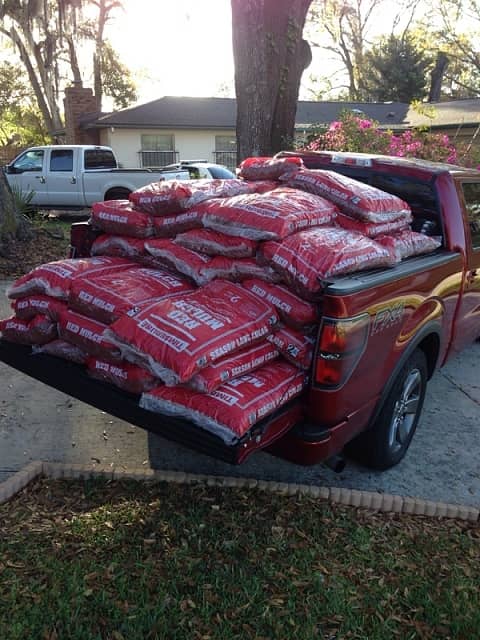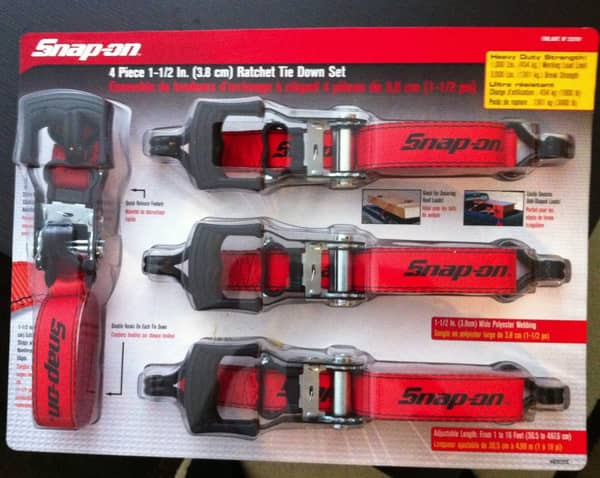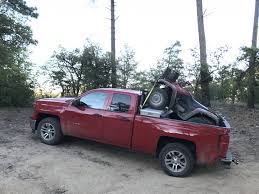One of the most often disregarded tenets to having a truck is learning how to strap down whatever kind of load you might be carrying. Everything you move is different, and how they should be transported will be different too.
How do you secure different loads in your truck bed? Secure the item using only high-quality straps and tie-downs. Place the item in a location that balances the weight and will prevent it from falling. Tighten the load down as much as possible.
When it comes to knowing what kind of load should be secured a certain way, there can be a deluge of information. Often this information could be false or not apply to what you are moving. Fear not! Read on and learn how to squash your fear of hauling.

How Do You Secure A Load In A Pickup Bed?
Trucks across the country serve several purposes for their owner. The bed is designed to carry cargo with the help of straps and tie-downs. If you have a flatbed, there should be places around the edges to secure your load. In today’s market, you can just about buy the exact truck you need for your job.
All beds are going to be different. Some will have larger wheel wells, and some will have an even smaller area for payloads. There are just a few steps to securing loads inside your truck bed. They are:
- Strap up
- Make it tight
- Truck capacity
- Get in position
- Watch your head
1. Strap up
If you are going to secure anything in your truck bed, you need something to hold it down. There are several schools of thought on this, and it all comes down to what you are hauling. The option you choose should be structurally sound and you should have enough of them to secure larger loads. Materials that tie-downs can be made from are:
- Chains
- Nylon Straps
- Rope
- String
- Wire Rope
Chains
When it comes to heavy-duty loads, like metal or stone, you might want to have more power to hold them down. Chains shouldn’t be used to move your grandmother’s prized furniture; it will scar it up something fierce. They are used for more massive objects and are rated when they are made. They rank anywhere from 1,300 to 8,800 lbs and will have a stamp on the links that tell you how reliable the chain is. Chains are bulky to store. If you have a smaller truck, they might not be an optimal option.
Nylon Straps

These are the most common types of load securing equipment these days. They are woven strips of nylon that are fed through a locking mechanism. You can find these in just about any general store across the country.
These are made for secure storage and operation. You can never go wrong with a good set of nylon ratchet straps. They can become frayed over time, and when this happens, you should discard the strap and replace it with a new one.
A good rule of thumb with nylon straps is that the wider they are, the stronger they are. If you are moving a massive load of bricks, you would need large belts. Whereas if you are moving your lawn mower across town, a small strap will do just fine.
Rope
Used for centuries and still a viable option today, a rope can be an excellent tie-down for your cargo. Like the nylon strap, the rope should be thrown away if it is frayed. The cord should be used for smaller hauls and be pulled as tight.
If they are stretched too tight, they can begin to fray on metal edges. Protect your rope if you are transporting an object with jagged or sharp edges. Some companies produce a rope with a special coating that protects from rough edges, but it will cost you.
String
A string is a little brother to the rope. This string should only be used for the smallest of jobs. If you have some heavy-duty industrial line, it could be used for hauling light furniture and even some small machinery. The string shouldn’t be an option for anything sharp around the edges or excessively burdensome. A string is the definition of easy to store. If you are in a bind, you could also make a net with some loose pieces of string.
Wire Rope
These are more of an industrial type of tie-down. Wire rope is made of high tensile strength strips of metal. These wires are woven into a string, and those strings are wound into a line.
This type of cable is used to provide the framework for some older bridges, like the Golden Gate Bridge. The wire rope is best used for industrial hauling. Large companies haul gas tanks and large air conditioners with wire rope. Don’t use wire on anything that is made of wood, unless it is going to the sawmill. The cable rubbing against the wood will remove the bark or coating over time.
2. Make it tight
Now that you have the appropriate tie-downs for your load, it is time to make sure that it doesn’t move. Reasons to secure a load include:
- Protecting you
- Protecting the cargo
- Protecting other drivers
- Protecting pedestrians
Before setting out with a heavy payload, make sure that it is tightened down.
Use your tie-downs across the top and back of the item. Pull down as much on the ties as is needed to keep the thing immovable. The entire purpose of hauling is to make the item arrive unharmed. Ensuring that the item is as secure as possible is the best way to guarantee this.
The tightening is undoubtedly the most important step of them all. You can haul without straps or completely covered, like in an eighteen-wheeler. The load will still need to be tight and secure. Not only does this protect against damaging the products, but your vehicle and others. A weight that moves around makes the trailer or vehicle hauling it unbalanced. This can cause the load to fly off the truck or the truck to fly off the road.
3.Truck capacity
The load that you are transporting must be within the limits of your truck. For example, if you have a full-size pickup, you can haul more than a mid-size. To ensure that you don’t overload your vehicle, you should look at the owner’s manual. It should give you the specifications for safely operating. Also, placing an undue burden on your engine will only mean the slow death of your vehicle.
4.Get into position
Having the weight secured is essential to this portion as well. If the load is towards the rear of the bed, you will have problems driving the vehicle. Excess weight in the wrong spot will cause the truck to weave and struggle to maintain a straight line. Think of balancing the load in concert to how the truck works. The weight must be adjusted to ride close to the cabin. Stacking smaller items on each side of a larger one is also a good idea..
It may seem like an inconsequential thing, but where the majority of the weight resides could mean success and failure. If you have a large refrigerator and it is laid on one side of the bed, that causes an unbalance. Place larger items centered in the bed to mimic the design of the truck. This also cuts down on excess airflow that could dislodge the object.
5.Watch your head
If you are hauling something much longer than the bed, you should attach something to warn others. The typical orange flag is a good choice, but any bright colored piece of material will work. The point is to ensure that other drivers can recognize the object before they crash headlong into it. Since the load is already higher off the ground than some cars, flagging the loose end will help other drivers see where the bundle ends.
When Should You Use Tie-Downs?
Several DOT offices across the country have a place to search for load requirements. If you take a look at their websites, you should find a section that specifies how whatever type of load you are hauling should be secured. To know just how many tie-downs you need you should consider this:
- How is the vehicle configured?
- How is the cargo placed?
- Are there other smaller items?
- How much height and weight is there?
One tie-down
The one tie-down section is for things that are smaller than five feet and under 1100 pounds. Also, for every ten feet of length of the item being hauled, you should add another tie-down. This rule applies more to trailers but isn’t a bad idea for hauling longer pieces of timber.
Two tie-downs
Anything longer than five feet and weighing more than 1100lbs should have at least two ties. This set up is the standard set forth by the Indiana DOT and could change depending on the location.
The single and two tie-down systems are the most basic of methods to secure the payload. This guideline is up for interpretation, but what isn’t in safety? If a load has less than two straps, it will not secure the item, plain and simple. To make sure that no movement happens, you should use the straps to ratchet the payload down to prevent any movement.
More Than Two
For the longer loads, you will need more straps. The rule of a strap every ten feet is an excellent rule of thumb, and when done correctly will give you all the coverage and protection that you might need. Safety for yourself and other motorists should always come first. For example, if you have a 30-foot section of wall that needs to be moved, there should be four equally spaced straps. One at the beginning and spaced out ten feet until the end.
How Should The Straps Be Spaced?
When you tell some people two straps, they will end up with both straps around some part of the payload that it isn’t supposed to be. The straps should be equally spaced from one another. Some states have laws governing the number of straps that should be used based upon the length of the cargo. A nationally recognized starting point is to have at least 5000lbs of payload you need roughly half that to secure the load.
How To Haul It
The biggest question when it comes to hauling is how to haul a specific type of object. Trucks are remarkable in that they can haul almost anything anywhere, with some help. Ensure your vehicle is capable of the job you have in mind, or there will be disastrous consequences. The most common questions about hauling are about how to haul:
- Large appliances
- Piano
- Couches
- ATV/UTV
- Timber
1.Large appliances
When you are hauling a large appliance, like a fridge, the rules stated earlier most definitely apply. Before moving the refrigerator, make sure that there are no items inside that could be broken. Shelving can be removed and placed flat inside the cab of the truck for protection. Depending on how many people you have, using a dolly or hand trucks to get the fridge to the truck would be an excellent idea.
If you are lucky enough to have a place to ease the appliance into the bed, then you are ahead of the game. If not, make sure that it stays upright as some models will take several hours to resume working if they are laid down. The freon inside will stop working, and that means no cooling for your food.
2.Piano

A piano is no small job to undertake. Moving a piano will be the most massive thing that some people ever have the misfortune of moving. Dollies and hand trucks will be essential for a job of this size. The most important parts of the piano are the keys and internal strings. Wrap or pack them with a soft material. A good idea is to pack it with blankets and wrap it with plastic before moving.
Once you have the piano ready for placement inside the truck, you should place it against the truck’s back wall. This makes the most challenging section in line with the cab and passengers. Use your straps to secure the piano to the back wall. Remember, no movement should occur. Strap it down tight.
3.Couches
Any person who has a truck has been asked to help someone move furniture. The next time someone asks you, you will know just what to do! A couch is one of those moves that we all have to make, and the best way to do it is together. Two people can handle your normal sized couch, but at least three people should try and tackle a sectional.
Placing the sofa inside the bed of the truck is an essential part of this job. It should be on its feet with something covering the cushions to prevent damage when moving. Any extra pillows or storage can be stowed inside the cab. The best bet is to ratchet strap down the sofa so that it doesn’t shift while transporting.
4.ATV/UTV
Moving an ATV/UTV can be a taxing job if you don’t have the correct tools. Ramps that can be safely placed onto the bed of the truck are what you will need. Some people will back their trucks close to a hill and try to climb the gap. Don’t do something stupid and dangerous. Do not try and have a makeshift ramp with no solid attachments. That is trouble. It could be a long back-breaking day of labor ahead of you without the right preparations.

Riding the machine on the ramps should be done at a slow controlled pace as not to smash the rear window of the truck. Once you have the ATV flush against that back wall, ratchet strap all four wheels to your tie-down spots. Adding some extra pressure will sink the UTV on its shocks and ensure that it isn’t going anywhere.
5.Timber
Trucks are made to conquer the world’s wildest terrains and haul any payload that they come across. With timber, there are some different rules to follow. If you have several pieces of wood that are longer than 10ft, you will have to bundle them with plastic, especially if they are tops of trees or loose boards.
A current trend in building is to tear down old barns and reuse the wood for new construction. These old boards could have jagged or rotten ends that will need to be bundled to ensure that they make the journey to their new home.
You might think that the pressure from other boards will keep them in place, but you would be wrong. If one of the tinier pieces slips away, you could have an avalanche of wood on the highway. Not good for you or your fellow drivers. Any pieces over 16ft will need a trailer, and you should also clearly display a bright colored flag on the ends to warn other drivers. If there is the possibility of tiny sticks or bark flying off, having a cargo net atop isn’t a bad idea.
Conclusion
Loading large items onto your truck can seem to be the most daunting part of transporting things, but making sure said items are properly secured is the most important. Be mindful of the important points such as using the proper amount of tie-downs, centering the object to promote a balanced truck, and using the right type of tie-downs. Always be sure a load is properly secured before driving off. It can be the thing that prevents you from experiencing utter disaster.
If you’re thinking of different ways to accessorize your truck or make it more functional, consider checking out my recommended accessories page. I spent a good amount of time picking out mods that can be useful for most pickup trucks.

